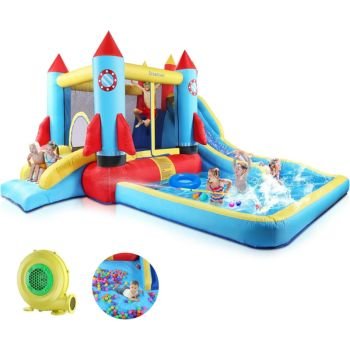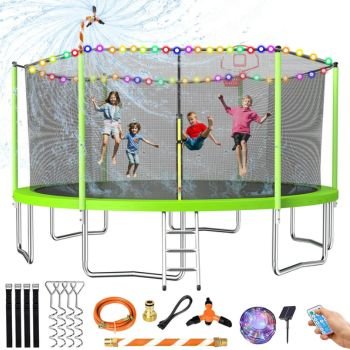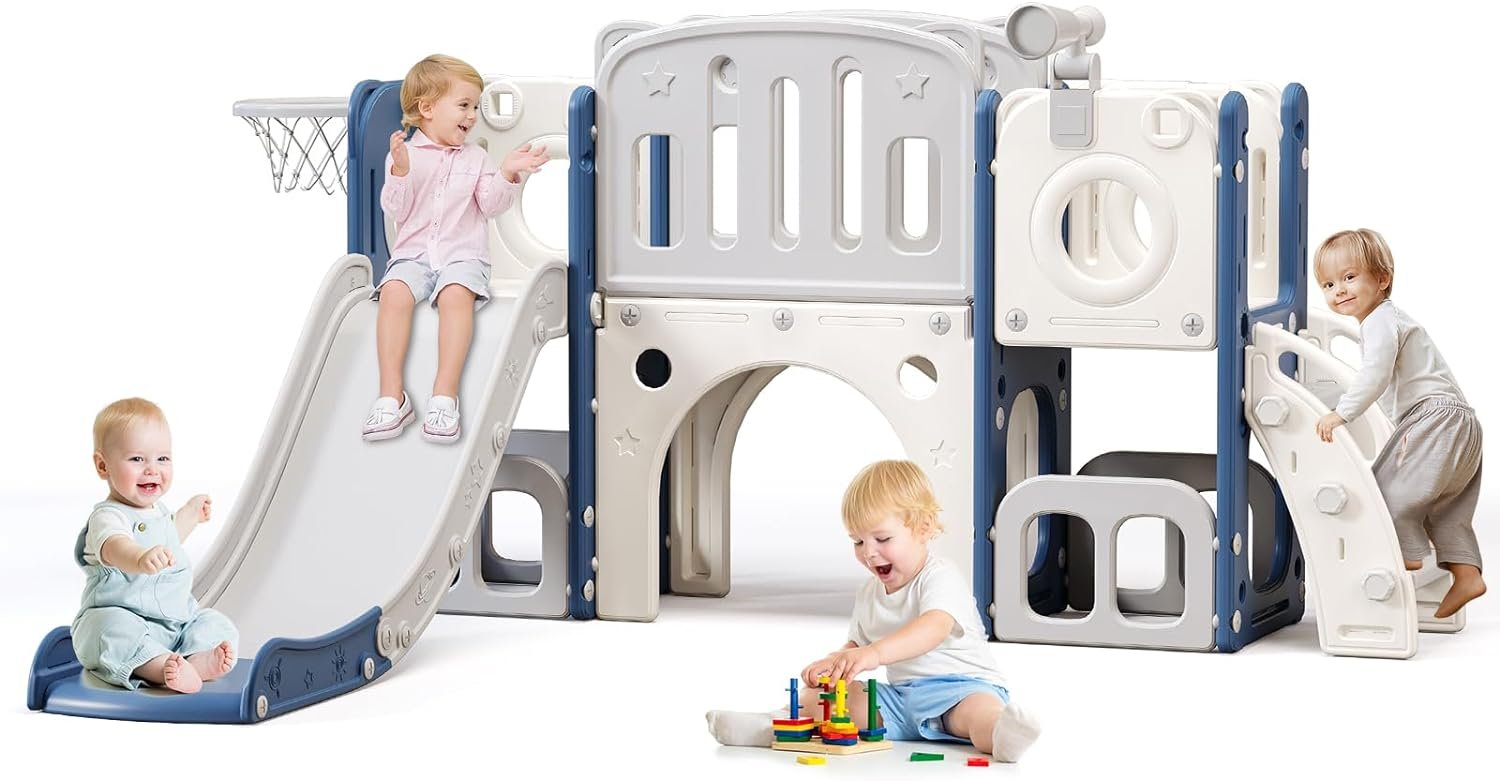Introduction to Montessori Learning
When it comes to early childhood education, the Montessori method has captured the attention of parents and educators worldwide. Rooted in the philosophy of Dr. Maria Montessori, this educational approach emphasizes independence, self-directed learning, and hands-on exploration. But what makes Montessori so different from traditional play? The answer lies in how children interact with their environment. Montessori isn’t about flashy toys that light up or play music—it’s about carefully designed tools that encourage children to think, explore, and learn naturally.
In recent years, Montessori-inspired playsets for toddlers have become increasingly popular. Parents are realizing that the toys they give their children in the early years can shape how they approach learning for the rest of their lives. Instead of pushing children into passive play where the toy does all the “work,” Montessori playsets are designed to encourage active participation. For example, instead of a talking doll that recites phrases, a Montessori doll might have simple clothing with buttons, zippers, and laces that allow the child to practice fine motor skills. This approach empowers toddlers to experiment, problem-solve, and build real-world skills through play.
Montessori play is also deeply connected to respect for the child’s natural curiosity. Every toddler is naturally eager to explore their world, and Montessori playsets are built to honor that. Rather than overwhelming them with too much stimulation, these toys encourage focus, concentration, and patience. Whether it’s stacking blocks, climbing on a wooden Pikler triangle, or experimenting with a sensory table, each activity supports developmental growth while still being fun and engaging.
What is the Montessori Method?
At its core, the Montessori method is an educational philosophy that emphasizes independence, freedom of choice, and hands-on learning. Dr. Maria Montessori believed that children learn best when they are allowed to guide their own learning within a carefully prepared environment. Instead of the teacher being the sole authority, the environment becomes the “teacher,” offering children opportunities to explore and discover at their own pace.
This method differs significantly from conventional play and learning approaches. In many traditional toys, the design is meant to entertain rather than teach. For example, battery-operated toys often sing songs, flash lights, and encourage repetitive button-pushing. While this may keep toddlers occupied, it doesn’t necessarily promote problem-solving or deep engagement. Montessori playsets, by contrast, avoid unnecessary noise and distraction, focusing instead on natural materials, textures, and open-ended possibilities.
For toddlers, this means that the toys they use should invite exploration without dictating how they should play. A set of wooden blocks, for instance, can become a tower, a bridge, or even a pretend food item depending on the child’s imagination. This freedom to invent is what sets Montessori play apart from mainstream toy culture.
Why Montessori Matters in Early Childhood Development
The toddler years are some of the most crucial in a child’s life. Between the ages of 1 and 3, children experience rapid brain development, forming neural connections that will shape their learning abilities for years to come. During this sensitive period, they absorb information from their surroundings like sponges. That’s why Montessori matters so much in early childhood—it provides a structured yet flexible way for children to explore and learn naturally.
Montessori-inspired playsets for toddlers focus on building fundamental life skills rather than passive entertainment. A toddler stacking wooden rings is not just playing—they’re learning about balance, size, order, and patience. A sensory table filled with rice, beans, or water introduces them to different textures while strengthening hand-eye coordination and concentration. These small activities may seem simple, but they lay the foundation for problem-solving, resilience, and creativity.
Moreover, Montessori play encourages independence. A toddler who learns to fasten buttons on a busy board is gaining both fine motor skills and a sense of accomplishment. Each success boosts confidence and motivates them to take on new challenges. This confidence-building aspect of Montessori play is essential in helping children grow into self-reliant, capable learners.
The Role of Play in Montessori Philosophy
Play is not “just play” in Montessori education—it is the very essence of learning. Dr. Montessori described play as the “work of the child,” emphasizing that children learn best when they engage in purposeful activities that feel meaningful to them. Montessori-inspired playsets are designed with this principle in mind, making sure that every activity contributes to skill-building while still being enjoyable.
Take the example of a climbing triangle, a popular Montessori playset. At first glance, it may look like a simple wooden frame. But for a toddler, it’s a world of adventure. Climbing builds strength, coordination, and balance. Sliding down teaches cause and effect. Crawling underneath sparks imaginative play—suddenly the triangle becomes a cave, a fort, or even a mountain to conquer. Unlike traditional plastic playgrounds, Montessori climbing sets are intentionally minimalist, allowing children to use their creativity instead of being directed by the toy.
Another key element of Montessori play is sensory learning. Toddlers thrive when they can use their senses—touch, sight, sound, taste, and smell—to make sense of the world. That’s why many Montessori playsets involve textures, shapes, and natural materials like wood, fabric, or metal. The goal is not to overwhelm, but to enrich their understanding of everyday objects and experiences.
✅ Related Articles
- How to Install a Swing Set: Step-by-Step Guide
- Discover the Ultimate Indoor Climbing Toys for Rainy Days
- DIY Playhouse Ideas for Budget-Friendly Parents
- How Much Space Do You Need for a Swing Set?
Benefits of Montessori-Inspired Playsets for Toddlers
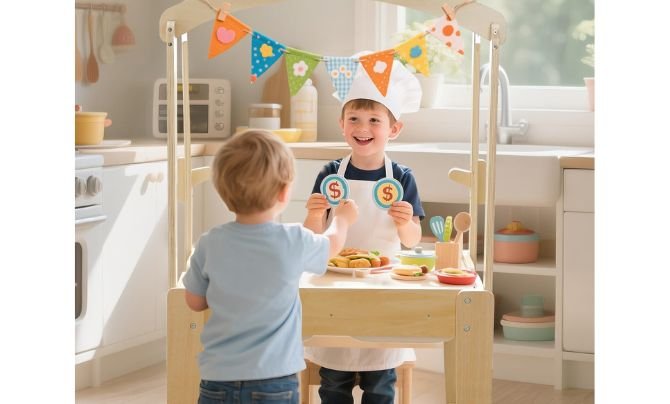
Parents often wonder: why choose Montessori-inspired toys when there are so many mainstream options available? The answer lies in the unique developmental benefits these playsets offer. They are not just toys—they’re tools designed to shape how children think, problem-solve, and interact with the world around them.
Encouraging Independence
One of the greatest benefits of Montessori-inspired playsets for toddlers is their ability to encourage independence. Unlike toys that require adult guidance or constant correction, Montessori toys are designed for self-directed play. A toddler doesn’t need a parent to press a button for the toy to work—they can figure it out on their own.
For example, busy boards with zippers, buckles, and buttons give toddlers the chance to practice everyday skills independently. When they manage to zip up a pocket or buckle a strap, they feel a sense of achievement. This independence fosters self-confidence and a willingness to try new tasks without fear of failure.
The Montessori method teaches us that when toddlers are trusted with responsibility, they rise to the occasion. Giving them the right playsets allows them to practice autonomy in a safe and supportive way, laying the foundation for lifelong self-reliance.
Boosting Cognitive and Motor Skills
Montessori-inspired playsets are carefully designed to support both cognitive and physical development. For instance, puzzles challenge problem-solving skills and logical thinking, while stacking toys build hand-eye coordination and fine motor control. These activities may seem like fun games, but they are essential exercises for growing brains.
Take a set of wooden nesting bowls. To a toddler, this may be a puzzle to figure out—which bowl fits inside the other? But in reality, they are learning about spatial awareness, sequencing, and comparison. Similarly, climbing structures promote gross motor skills by strengthening muscles, balance, and coordination.
The beauty of Montessori toys is that they provide multiple layers of learning in one simple design. They don’t just entertain—they actively engage the brain and body, encouraging growth on all levels.
Fostering Creativity and Imagination
Another powerful benefit of Montessori playsets is how they inspire creativity. Unlike electronic toys that dictate a storyline or provide specific instructions, Montessori toys leave the play experience open-ended. A set of wooden blocks can transform into a castle, a road, or a pretend dinner. A climbing triangle can be a fort one day and a pirate ship the next.
By avoiding overly structured designs, Montessori toys allow children to explore their imagination freely. This open-ended play fosters creativity, problem-solving, and resilience. When toddlers are given the freedom to experiment, they learn to think outside the box and develop original ideas—skills that are crucial not just in childhood, but throughout life.
Building Problem-Solving Skills
Problem-solving is at the heart of learning, and Montessori playsets are designed to challenge children in just the right way. For example, shape sorters and puzzles require toddlers to think critically about where each piece fits. Climbing structures present physical challenges that teach children how to take risks safely, assess their environment, and make decisions.
What sets Montessori apart is that these challenges are never too overwhelming. The toys are intentionally designed to be just difficult enough to stretch the child’s abilities without causing frustration. This balance helps toddlers develop persistence, resilience, and confidence in their problem-solving abilities.
Key Features of Montessori Playsets
When shopping for Montessori-inspired playsets for toddlers, it’s important to understand what makes them different from conventional toys. These playsets aren’t about flashy designs or battery-operated functions—they’re about thoughtful simplicity, intentional design, and a focus on child development. Each feature of a Montessori playset serves a purpose, helping toddlers grow through exploration and discovery.
Simplicity and Natural Materials
One of the core principles of Montessori playsets is simplicity. Unlike modern toys that often come with buttons, flashing lights, and pre-programmed sounds, Montessori toys are designed with minimalism in mind. Why? Because simple toys invite complex play. A wooden block might seem basic compared to a talking robot, but it sparks more creativity because the child has to imagine what it could be.
Natural materials also play a big role. Many Montessori playsets are made of wood, fabric, or metal rather than plastic. Wooden toys, for instance, provide a unique texture and warmth that toddlers find engaging. They are also more durable and sustainable, making them both eco-friendly and long-lasting. By surrounding toddlers with natural materials, parents can encourage a deeper connection to the environment while providing safer, non-toxic options for play.
Simplicity and natural textures help children focus. When there aren’t overwhelming lights or sounds, toddlers can concentrate longer and engage more meaningfully with their toys. This kind of focus is a cornerstone of Montessori learning.
Open-Ended Play Possibilities
Another defining feature of Montessori-inspired playsets for toddlers is open-ended play. These toys are intentionally designed without a fixed outcome, meaning children can use them in endless ways. For example, a set of stacking cups isn’t just for stacking—it can become a tea set, a drum, or even a pretend tower in a toddler’s imagination.
This open-endedness is crucial because it encourages problem-solving and creativity. When children aren’t told how to use a toy, they naturally experiment, explore, and invent. They become the creators of their play experience instead of passive participants. This level of freedom fosters independence and adaptability—skills that extend far beyond childhood.
Parents often notice that Montessori playsets “grow” with their children. A toy that a toddler uses for stacking today may become part of an elaborate imaginative game a year later. Unlike toys with limited functions, Montessori-inspired playsets offer value for years, adapting to the child’s developmental stage.
Safe and Toddler-Friendly Design
Safety is always a top concern for parents of toddlers, and Montessori-inspired playsets are designed with this in mind. The toys typically avoid small, detachable parts that could be choking hazards. They are often built with smooth, rounded edges and finished with non-toxic, child-safe paints and coatings.
Additionally, Montessori toys are developmentally appropriate. Each playset is crafted to match the physical and cognitive abilities of toddlers, meaning they challenge the child just enough without being overwhelming. For example, a climbing triangle encourages physical movement but is built at a height that minimizes risk while still allowing for adventure.
By prioritizing safety and usability, Montessori playsets allow toddlers to explore independently while giving parents peace of mind. This balance is essential in creating a secure learning environment.
Durability and Sustainability
Montessori-inspired playsets for toddlers are known for their durability. Since they are often made from high-quality wood and sturdy craftsmanship, these toys can withstand years of use. Unlike plastic toys that easily break or wear out, Montessori toys are designed to last through multiple stages of childhood—and often even get passed down to siblings.
Sustainability is another important aspect. Many Montessori brands are committed to eco-friendly practices, using responsibly sourced wood, recyclable materials, and natural finishes. This not only benefits the environment but also ensures that the toys children are playing with are safe and free from harmful chemicals.
Parents who invest in Montessori playsets often find that the higher quality is worth the cost. Instead of constantly replacing broken toys, they end up with long-lasting, timeless pieces that support their child’s development in meaningful ways.
Popular Montessori-Inspired Playsets for Toddlers
With so many options available, it can feel overwhelming to choose the right Montessori playset. However, certain types of playsets stand out as favorites among parents and educators alike. These toys have been proven to support toddlers’ development while offering endless hours of play.
Wooden Climbing Structures
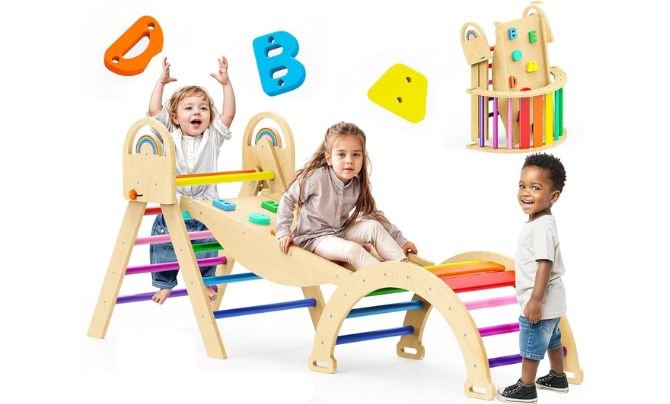
Climbing structures, such as the Pikler triangle, are staples in many Montessori households. At first glance, these look like simple wooden frames, but they are powerful tools for physical development. Toddlers use them to climb, balance, crawl under, and even drape blankets over to create imaginative forts.
These structures encourage gross motor development, coordination, and confidence. By practicing climbing, toddlers strengthen their muscles, improve balance, and learn spatial awareness. They also develop independence by testing their own limits in a safe, supportive environment.
What makes climbing structures particularly special is their versatility. They can be combined with ramps, slides, or arches to create endless play opportunities. Parents often find that these structures keep toddlers engaged for years, adapting to different stages of growth.
Montessori Busy Boards
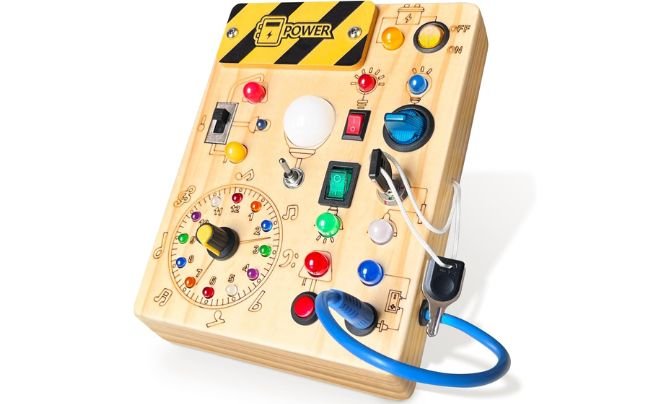
Busy boards are another popular choice for toddlers. These boards are filled with everyday objects like zippers, latches, switches, and buckles. While they may seem simple, they offer toddlers valuable practice with real-world skills. Instead of playing with digital buttons that light up, toddlers get the chance to explore objects they’ll encounter in daily life.
Busy boards strengthen fine motor skills and hand-eye coordination. They also encourage problem-solving, patience, and independence. When a toddler figures out how to fasten a buckle or zip up a pocket, it builds confidence and prepares them for everyday tasks like dressing themselves.
Parents love busy boards because they provide quiet, focused play. They’re also compact and travel-friendly, making them great for car rides or waiting rooms.
Sensory Play Tables
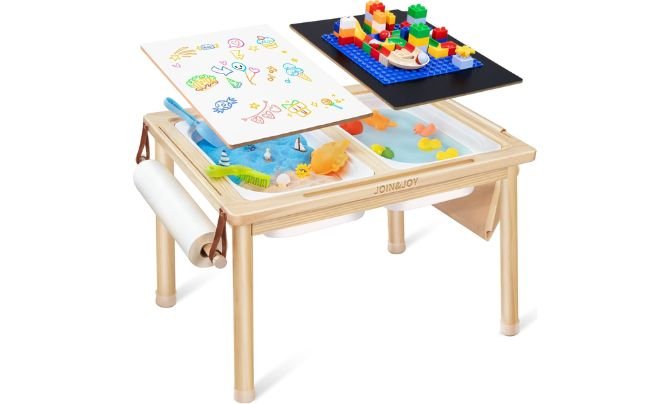
Sensory tables are fantastic Montessori-inspired playsets for toddlers because they allow children to engage multiple senses at once. These tables often come with compartments that can be filled with sand, water, rice, beans, or other textured materials. Toddlers can scoop, pour, sift, and dig—activities that strengthen hand coordination and concentration.
Beyond physical development, sensory tables also support language learning and problem-solving. For example, while playing with water, a parent might introduce new vocabulary words like “float,” “sink,” “wet,” or “dry.” This type of interactive play enriches both sensory and cognitive development.
The versatility of sensory tables makes them long-lasting. As children grow, the play evolves—toddlers may simply enjoy pouring and scooping, while older kids might build imaginative small-world play setups with animals, cars, or figurines.
Wooden Stacking Toys and Puzzles
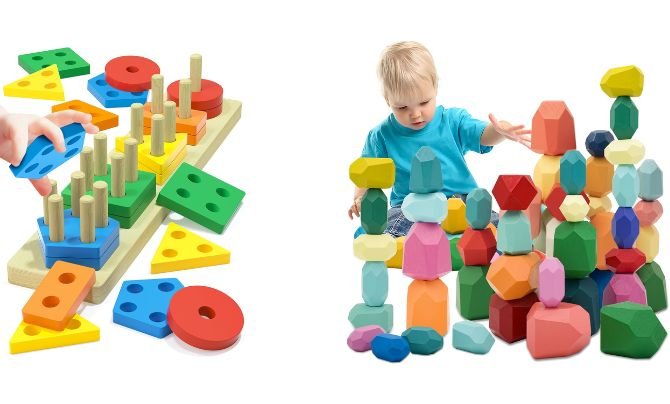
Stacking toys and puzzles are classic Montessori tools that never go out of style. Wooden stacking rings, nesting cups, and shape sorters all challenge toddlers to think critically while practicing fine motor skills. These toys also introduce early concepts of size, shape, order, and balance.
For example, a toddler stacking rings learns about sequencing and hand control. A puzzle teaches problem-solving by requiring the child to fit pieces into specific spaces. These seemingly small tasks lay the groundwork for mathematical thinking and logical reasoning later in life.
Because they are simple yet versatile, stacking toys and puzzles can be used in many ways. They can be combined with imaginative play or introduced as quiet, focused activities during learning time.
Kitchen Playsets with Realistic Utensils
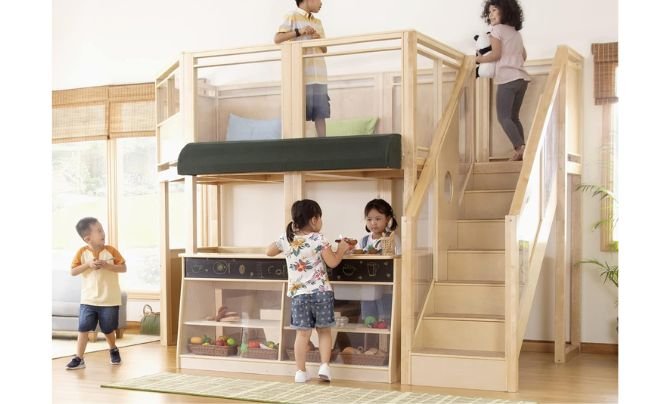
Toddlers love imitating adults, and kitchen playsets give them the perfect opportunity to do so. Unlike flashy plastic kitchens with electronic features, Montessori-inspired kitchen sets use realistic, scaled-down utensils and tools. A wooden spoon, small cutting board, or child-sized pots allow toddlers to engage in pretend cooking while learning practical life skills.
These playsets promote independence by letting toddlers “help” in the kitchen in a safe way. They can pretend to prepare meals, stir ingredients, or serve food, all while strengthening motor skills and creativity. Over time, these play experiences translate into real-world abilities, like helping with simple cooking tasks under supervision.
Kitchen play also fosters social skills, as toddlers often enjoy “cooking” for parents, siblings, or friends. It becomes a shared activity that teaches communication, cooperation, and empathy.
👉 You Might Be Interested In
- Best Seesaws & Rockers for Backyard Fun: Safe Choices Kids Love
- 25+ Must-Have Accessories for Kids’ Playhouses That Children Will Love
- The Truth About Swing and Slide Combo Playsets | Pros, Cons
- Small Backyard? Here Are 10 Must-Have Playsets for Kids
- Premium Wooden Swing Sets | The Ultimate Backyard Upgrade in 2026
- Swing Set Safety Tips Every Parent Must Know | Ultimate Guide
- DIY Swing Set vs Store-Bought: Pros and Cons for Families
How to Choose the Right Montessori Playset for Your Toddler
With so many wonderful Montessori-inspired playsets for toddlers available, how do you know which one is right for your child? Choosing the best playset depends on several factors, including your toddler’s age, interests, developmental needs, and the space you have available.
Age-Appropriate Options
Montessori playsets are most effective when they align with a child’s developmental stage. A climbing structure might be perfect for a 2-year-old building strength and coordination, while a busy board is ideal for an 18-month-old practicing fine motor control. Choosing age-appropriate toys ensures that your toddler is challenged without becoming overwhelmed.
It’s also important to remember that Montessori toys “grow” with the child. Many playsets are versatile and can be used in different ways as toddlers develop new skills. Investing in these adaptable toys provides long-term value and ongoing developmental support.
Matching Your Toddler’s Interests
One of the most powerful aspects of Montessori education is its emphasis on following the child’s natural interests. The same applies when choosing Montessori-inspired playsets for toddlers. If your child loves movement and physical activity, a climbing triangle or balance beam may be the perfect choice. On the other hand, if they’re fascinated by small details and objects, a busy board or puzzle set may better capture their attention.
Observing your toddler’s play habits can provide valuable clues. Do they enjoy stacking, sorting, and building? Then opt for wooden blocks, nesting cups, or shape sorters. Are they drawn to pretend play? A child-sized kitchen set or realistic tools may spark their imagination. By aligning toys with interests, you ensure longer-lasting engagement and a deeper sense of joy in play.
This personalized approach also prevents toy clutter. Instead of filling your home with random toys that only hold your child’s attention for a few days, Montessori playsets encourage meaningful play that resonates with their personality and developmental needs.
Considering Safety and Space
Safety and space are two critical factors when selecting Montessori-inspired playsets for toddlers. Since toddlers are naturally curious explorers, their play environment should be designed to minimize risks. Look for toys made from non-toxic, child-safe materials with smooth edges. Avoid playsets with small detachable pieces that could pose choking hazards. Always check age recommendations before introducing a new toy.
Space is another important consideration. While smaller playsets like busy boards and puzzles fit easily into any home, larger climbing structures or sensory tables require more room. Before purchasing, consider where the playset will be placed and how much space your toddler has to explore freely. For small apartments, foldable Montessori climbing structures or compact sensory bins are great space-saving alternatives.
Additionally, think about storage. Many Montessori-inspired toys are designed to be neatly organized, teaching toddlers the importance of order. Having a designated space for each toy not only keeps your home tidy but also reinforces Montessori principles of responsibility and care for the environment.
Budget-Friendly vs. Premium Playsets
When parents first look into Montessori-inspired playsets for toddlers, they often notice that many of these toys come with a higher price tag compared to mass-produced plastic toys. This is because they are typically crafted from durable, eco-friendly materials like solid wood and designed to last for years. While premium playsets may feel like a big investment upfront, they often provide better long-term value.
That said, Montessori doesn’t have to be expensive. There are plenty of budget-friendly options available that still embody Montessori principles. For example, simple wooden blocks, stacking rings, and sensory bins can all be affordable yet highly effective. Some parents even create DIY Montessori-inspired toys using everyday household items, such as a basket of fabric scraps for sensory play or a muffin tin with balls for sorting activities.
When deciding between budget-friendly and premium playsets, consider the longevity of the toy. A premium climbing structure might last through multiple children and adapt to different developmental stages, while cheaper alternatives may wear out quickly. The key is to find a balance that works for your family’s needs and resources while staying true to Montessori’s focus on simplicity and quality.
Conclusion
Montessori-inspired playsets for toddlers go far beyond entertainment. They are thoughtfully designed tools that foster independence, creativity, problem-solving, and lifelong learning. By focusing on simplicity, natural materials, and open-ended possibilities, these playsets empower toddlers to explore the world in their own unique way.
Whether it’s climbing a wooden structure, experimenting with a sensory table, or practicing fine motor skills on a busy board, Montessori play creates meaningful opportunities for growth. Choosing the right playset means considering your child’s age, interests, and environment, while also balancing quality and budget.
In a world full of flashy, electronic toys that often provide passive entertainment, Montessori-inspired playsets stand out as timeless, purposeful, and developmentally rich. They remind us that children don’t need more noise or stimulation—they need space, freedom, and simple tools that nurture curiosity and imagination.
Investing in Montessori-inspired playsets is not just about play—it’s about giving your child the foundation for independence, confidence, and a lifelong love of learning.
FAQs
1. What age is best to introduce Montessori-inspired playsets for toddlers?
Most Montessori toys can be introduced as early as 6 months, but toddler-specific playsets are generally best for ages 1–3. The key is to choose toys that are developmentally appropriate for your child’s stage.
2. Are Montessori playsets safe for toddlers?
Yes, Montessori playsets are designed with toddler safety in mind. They use non-toxic materials, smooth finishes, and developmentally appropriate designs to ensure safe play.
3. Do Montessori playsets work in small homes or apartments?
Absolutely. While larger climbing structures require more space, there are plenty of compact Montessori options such as puzzles, busy boards, and stacking toys that work well in small spaces.
4. How do Montessori playsets differ from regular toys?
Unlike regular toys that often rely on batteries, lights, or sounds, Montessori playsets are simple, natural, and open-ended. They encourage active learning and creativity instead of passive entertainment.
5. Are Montessori-inspired playsets worth the investment?
Yes. While some can be pricey, their durability, sustainability, and long-term developmental benefits make them a valuable investment for your child’s growth.





